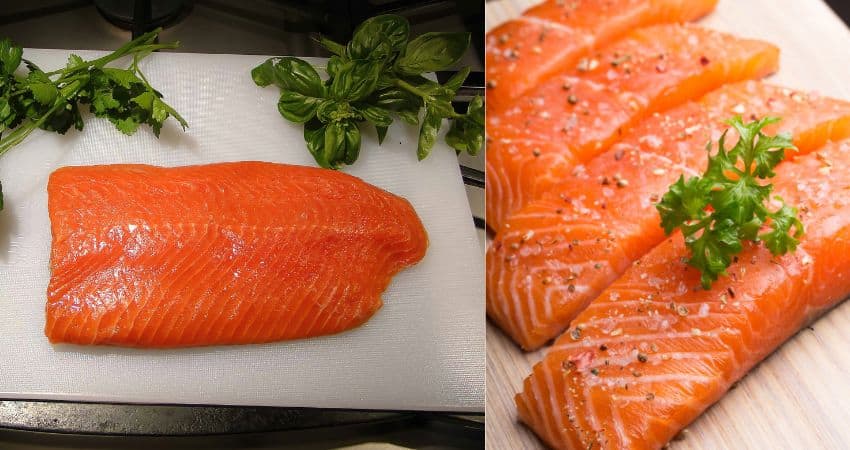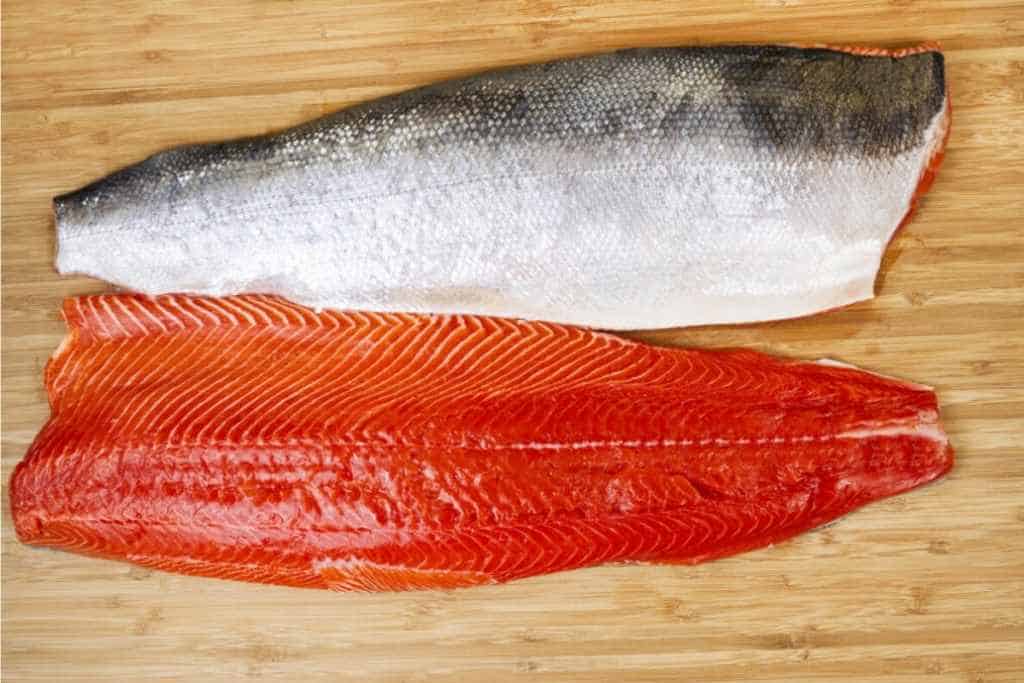Pink Salmon vs Sockeye: The Complete Comparison
Pink and sockeye salmon are both commonly eaten species of salmon. Many people wonder which one is better.
Sockeye salmon is better than pink due to its higher percentage of fatty acids. Sockeye provides 35% more omega-3, 20% more B6, 13% more B12, 5% more B5, 70% more thiamin, 91% more riboflavin, 6% more niacin and 50% more folate more than pink salmon. Sockeye contains more vitamin A, calcium and zinc.
First, this article will include a side-by-side nutrient comparison between the two fish. I’ll compare their tastes, textures, costs and whether one can substitute for the other. If you’re wondering if one has more mercury than the other, I’ll discuss their mercury levels also.
Pink Salmon and Sockeye Nutritional Values

As a Certified Health Coach many clients ask me about food comparisons including salmon. I purchase and consume salmon every week. Therefore, I have researched this topic in the past and present. Let’s examine them closely starting with nutrients.
The following table compares the nutrients contained in pink and sockeye salmon:
| Nutrient | Pink Salmon, raw (4 Ounces) | Sockeye Salmon, raw(4 Ounces) |
| Calories | 144 | 149 |
| Fat | 4.9 g | 5.3 g |
| Protein | 23 g | 25 g |
| Omega-3 | 0.70 g | 0.96 g |
| B-6 | 0.69 mg | 0.82 mg |
| B-12 | 4.71 mcg | 5.32 mcg |
| Thiamin | 0.09 mg | 0.15 mg |
| Riboflavin | 0.12 mg | 0.23 mg |
| B5 | 1.16 mg | 1.21 mg |
| Iron | 0.43 mg | 0.49 mg |
| Vitamin A | 39.69 mcg | 55.57 mcg |
| Niacin | 9.06 mg | 9.64 mg |
| Folate | 4.54 mcg | 6.80 mcg |
| Potassium | 415 mg | 416 mg |
| Magnesium | 30 mg | 34 mg |
| Phosphorus | 295 mg | 291 mg |
| Calcium | 7.94 mg | 10.21 mg |
| Zinc | 0.44 mg | 0.52 mg |
| Selenium | 35.6 mcg | 33.8 mcg |
Nutrition Sources1 ((Nutrition Value: Fish, raw, sockeye, salmon))
Taking a look at the nutrients of both fish, it’s easy to see they contain many vitamins and minerals.
Sockeye is healthier than pink salmon due to its higher number of omega-3 fatty acids, vitamins and minerals. Sockeye contains more B6, B12, B5, riboflavin, thiamin, iron, niacin, folate, magnesium, calcium, zinc and vitamin A than pink salmon.
Although pink salmon is healthy and contains many beneficial nutrients, just not as much as sockeye. Pink salmon contains more phosphorus and selenium than sockeye. Both fish provide similar amounts of potassium, protein, fat and calories ((FDA: Seafood Nutrition Facts)).
Pink Salmon vs Sockeye Taste

Sockeye salmon has a rich, fishy flavor many people enjoy. By many, it is considered to be the second best tasting species of salmon. These fish are packed with flavor, so you definitely won’t have to eat bland fish when you’re eating a dish made with sockeye salmon.
It is slightly oily at times, but most people don’t notice because of the other ingredients added to their dish. It’s not overly oily, therefore, this isn’t a big drawback.
However, people who don’t like the flavor of fish will not like the flavor of sockeye salmon because the fishy flavor may be too much. It’s not overpowering to most, but it is worth keeping in mind.
Pink salmon has a very mild and oftentimes bland flavor. It adopts the flavor of whatever spices are added to it rather than relying on its own flavor.
While sockeye salmon keeps its flavor and is emphasized by spices and seasonings, pink salmon takes on the flavor of added spices.
Now you know about the taste of sockeye and pink salmon, you are likely wondering about their texture. Let’s compare the textures of the two.
My Poll and Taste Test at Home
I wanted to get the opinion of real people like you and me. Therefore, I wanted to conduct my own research and contacted my clients, readers and members of food groups I belong to. I asked them which salmon they preferred.
- 55% said they preferred the taste of sockeye salmon.
- 35% said they preferred the taste of Atlantic.
- 10% said they had no preference, or it depended on their mood.
I also set up a blind test taste at my home. I prepared both salmons the same way using the same seasonings. Four out of six people, 66% chose sockeye salmon. They said the texture and flavor was better.
Pink Salmon and Sockeye Texture
Sockeye salmon is slightly thin and fatty, but it has quite a rich texture. This texture is nice because it is not the fattiest species of salmon on the market. The fattiness of this salmon makes the texture quite nice and almost buttery when it is cooked correctly.
Sockeye salmon is quite firm and is considered to be the salmon species that has the firmest flesh. Although the flesh is firm and dense, that doesn’t mean it’s tough to chew.
In fact, it is very easy to eat sockeye salmon when it is properly cooked and it almost melts in your mouth.
Pink salmon has a great texture, quite soft and tender when it is fully cooked ((FishChoice: Pink Salmon)). Its texture is often compared to tuna2. It’s more delicate and goes well with lighter foods ((Pure Alaska Salmon Co: Red Salmon Versus Pink Salmon Versus Tuna)).
I wrote another article comparing two types of salmon, keta and sockeye salmon. Check it out here, Keta vs Sockeye Salmon: What’s The Difference?
Substitutions for Pink and Sockeye Salmon
Sometimes, it is difficult to find fresh, high-quality pink or sockeye salmon, even if you go to a local fish market. This is because sockeye and pink salmon are only caught from April to the middle of October in most areas.
This means from October to the end of March, there isn’t any fresh sockeye or pink salmon to be found, although you can find both species of salmon frozen at your local supermarket.
If you can’t find sockeye or pink salmon, you may be wondering if you can substitute pink salmon for sockeye.
Pink salmon and sockeye can substitute for each other in recipes, although they have slightly different textures and tastes. They both can be cooked using many of the same methods like slow-roasted, poached, fried or baked. Substitute the same weight and type of cut.
When substituting pink salmon for sockeye, certain sauces and ingredients that go well with one should be fine with the other3.
Pink Salmon or Sockeye: Mercury
The Food and Drug Administration and the Environmental Protection Agency have issued warnings regarding mercury levels. They also provide recommendations about how often people should consume each fish4.
They established a list of fish that are best choices, good choices and ones to avoid. Therefore let’s examine pink salmon and sockeye.
Pink salmon and sockeye salmon have similar levels of mercury. Both fish are listed on the FDA’s best choices of fish to consume regarding their mercury levels. The recommendation is consuming them no more than two to three servings a week.
Always check with a physician prior to eating new foods or changing your dietary habits.
If you’re interested in finding out how the sockeye salmon compared to coho salmon, check out my article here, Coho Salmon vs Sockeye: What’s The Difference?
Pink Salmon vs Sockeye: Cost
When you are purchasing pink salmon or sockeye, be sure to check the label to see if the fish is wild caught or farm-raised. This makes a difference with cost as wild is always more expensive. In addition, your area, store and whether the fish is frozen or fresh changes the price.
Sockeye salmon is more expensive than pink salmon. The average cost for fresh wild caught sockeye salmon is $16.74 per pound while the average cost for fresh wild-caught pink salmon is $12.49 per pound.
I visited and checked my local Shoprite and Stop and Shop supermarkets. The following are the prices for pink and sockeye salmon:
- Fresh wild pink fillet
- $10.99 per pound
- Fresh wild sockeye salmon
- $14.99 per pound.
I checked FreshDirect and found the following prices for pink and sockeye salmon:
- Fresh wild pink fillet
- $13.99 per pound
- Fresh wild sockeye fillet
- $18.50 per pound
How to Tell Sockeye and Pink Salmon Apart
Sockeye and pink salmon often do not look very similar, even after they are skinned and cut.
Sockeye salmon ranges in color from bright orange to a dark or bright red. Their flesh’s color changes depending on how many shrimp and crustaceans they eat before they are caught and killed.
Sometimes sockeye salmon can be pink, but it is generally more of a pinkish-red color than a pure pink ((Wikipedia: Sockeye salmon)).
Meanwhile, pink salmon ranges in color from a light color to a bright pink when it is uncooked. If you are purchasing a whole fish, pink salmon are silver and have green and black dots near their top fin.
They do change color during spawning season, as a yellow color spreads down their flank, but they are still silver. Sockeye salmon look completely different than pink salmon, especially during spawning season.
Sockeye salmon are silvery-blue when it is not spawning season. When spawning season begins and they move from the ocean to rivers and lakes, they turn red and green. Their slightly curved snout turns green and their flank becomes bright red, which is one of the reasons why they are often called the red salmon.
Look at the color of the fillet you are looking at to determine which type of fish it is. If you’re still unsure which one is which, ask someone who works in the area or one of the workers in the fish market.
If you have any questions to ask me about this article don’t hesitate to comment below or email us. You can find an email on our contact page.
Read Next – More Salmon vs Salmon Articles!
Atlantic vs Wild Salmon: Which Is Better?
Pink vs Red Salmon: What’s The Difference?
Atlantic vs Pacific Salmon: What’s The Difference?
Frozen Salmon vs. Canned Salmon: Which Is Healthier?
Sockeye vs King Salmon: A Complete Comparison
- Nutrition Value: Fish, raw, pink, salmon [↩]
- Alaska Department of Fish and Game: Pink Salmon [↩]
- Sea Grant North Carolina: Fish Flavors and Substitutions [↩]
- FDA: Advice about Eating Fish [↩]
